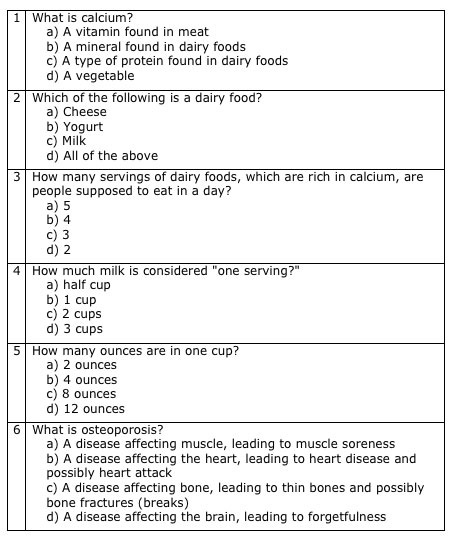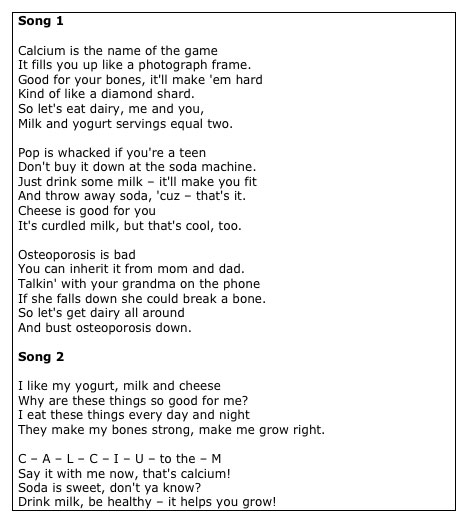 |
October 2010
|
October 2010 // Volume 48 // Number 5 // Ideas at Work // v48-5iw4
Promoting Dairy Intake in Rural Wisconsin by Empowering Youth
Abstract
Only 30% of children in the U.S. are currently meeting the Dietary Reference Intake for calcium. A "3-A-Day of Dairy for Stronger Bones" campaign was promoted by older Scouts to younger Scouts in a small rural village in southern Wisconsin. The hypothesis was that by teaching the importance of dairy to younger children, the older children would be empowered to increase their own intake. Knowledge and intake improved for calcium and dairy products in the intervention group as compared with those who were not involved in teaching the younger children. Summer educational programs are needed to encourage dairy consumption.
Background
Calcium is part of a healthy diet and plays a necessary role in building strong bones early in life and maintaining bone mineral density later in life. Optimizing the intake of calcium from dairy foods during the adolescent years is essential for achieving peak bone mass and maintaining bone health (Heaney & Weaver, 2005). Protein and other nutrients available in dairy foods can prove to be beneficial for both adolescents and adults. In addition, the inclusion of dairy may be beneficial during weight loss or weight maintenance (Van Loan, 2009).
The Dietary Reference Intakes for calcium are age-specific and are expressed as Adequate Intakes (AI). For children aged 9-18 years old, the AI has been set at 1,300 milligrams for boys and girls (Institute of Medicine, 1997). A 6-week nutrition education program aimed at preadolescents was successful in lowering carbonated beverage and fruit-drink intake, but did not result in an increase in milk intake (Roth-Yousey, Caskey, May, & Reicks, 2007). Thus, innovative ways to increase calcium intake among youth are needed.
Program Description and Objectives
The hypothesis of the intervention described here was that youth who are actively engaged in educating younger children about dairy products and their health benefits will improve their own dairy intake when compared with those who are not involved in mentoring younger children. Older Girl and Boy Scouts between the ages of 11 and 17 years, from a small, rural village in southwestern Wisconsin (Village A), were recruited to participate as mentors to their younger scouting counterparts. The intervention was approved by the Social & Behavioral Sciences Institutional Review Board at the University of Wisconsin-Madison. Along with mentoring, the older Scouts developed a "3-A-Day" dairy campaign for the younger Scouts. The troop leaders were heavily involved in the successful implementation of the project.
Scouts were invited to half-day educational sessions where the benefits of milk, yogurt, and cheese were presented through an interactive PowerPoint. Girl and Boy Scouts within the same age range were also recruited from a neighboring village (Village B) to attend educational sessions, but not to participate in the mentoring process. Prior to the educational sessions, nutrition interns and dietitians from the University of Wisconsin-Madison Hospital and Clinics conducted diet histories and baseline nutrition assessments on each participant. A six-question multiple-choice pre/post-test was administered (Figure 1).
Figure 1.
Pre- and Post-Test Administered
to Boy and Girl Scouts

The Scouts were educated through other interactive activities designed to improve their understanding of the importance of dairy. These activities included:
- Making and taste-testing yogurt smoothies
- Calculating the calcium, vitamin D, and protein in foods from three different grocery bags representing an adequate-dairy diet, a low-dairy diet, and a "junk-food" diet
- Visually illustrating the calcium content of various beverages and snack foods using plastic bags filled with mini-marshmallows to represent calcium
- Writing dairy "rap" songs to promote dairy to young children (Figure 2)
Figure 2.
Two Original Dairy Rap Songs
Written by Participants and Performed to Younger Children

Materials were distributed and prepared by the intervention group for the mentoring sessions. Team members and troop leaders provided general oversight. Dairy-themed materials were obtained from various sources and included: coloring books (National Institutes of Health); calcium and physical activity journals (Department of Health and Human Services); "3-A-Day of Dairy" dry-erase trackers, balloons, pencils, buttons, and notepads (purchased from the Spartan Promotional Group); and brochures (Wisconsin Milk Marketing Board and the National Institutes of Health). Three hundred half-pints of milk and 340 individual cheese sticks were distributed by the intervention group at local events, such as fundraisers and the school cafeteria. One of the most popular events was a milk mustache booth held at the annual all-Girl Scout winter beach party. For this event, whipped cream was used to "paint" on a mustache, and individual photos were taken with a Polaroid camera.
Outputs and Outcomes
Forty Scouts from the intervention group in Village A were recruited. The mean age was 13.1 ± 1.6 years; the group was 71% female. Fifteen Scouts from control Village B were recruited. The mean age was 14.7 ± 1.9 years; the group was 47% female. Eighty percent of the subjects in the intervention group and 73% of the subjects in the control group attended the educational session. Pre- and post-educational session test scores were calculated for both groups and improved on the post-test. There was a mean 60% score on the pre-test, with an increase to 88% on the post-test in the intervention group. Significant improvement on the following questions was observed: What is calcium? How many servings of dairy per day are recommended? How many ounces are in one cup? What is osteoporosis? In the control group, the pre-test mean score was 75%, with an increase to 88% on the post-test. Improvement on the following questions was observed: What is calcium? How many ounces are in one cup?
From the dietary assessment evaluations, baseline dairy consumption was 3.8 and 4.2 servings in the intervention and control groups, respectively, during the school year. These values changed to 4.4 and 3.9 servings in the intervention and control groups, respectively, after the "3-A-Day" campaign, which ended after school was no longer in session.
Conclusion
Although dairy intake in rural Wisconsin was originally high and usually met MyPyramid recommendations of 3 cups per day for this age range (MyPyramid.gov, 2005), the "3-A-Day" campaign had an impact on the dairy consumption of the youth in the intervention group, especially that of the girls. Dairy intake was lower in the control group after the school year ended. This suggests that dairy intake of the youth was buoyed during the school year, and we propose that this was largely due to the availability of milk in the lunch program and in school vending machines. This poses an important challenge for educators and/or nutritionists to develop programs that will encourage youth to maintain dairy intake during the summer months. This empowerment model of mentoring younger children may be useful in summer educational programs, perhaps in conjunction with 4-H activities (Bourdeau & Taylor, 2007). Generally in the U.S., we should continue to encourage children to get more calcium (Williams, 2006).
Acknowledgements
This project was funded through a Nutrition Education Grant from the 3-A-Day of Dairy for Stronger Bones sponsored by the National Dairy Council. We thank all of the sponsors that donated materials for the mentoring session. We also thank Rebecca Surles and Kirsten Karatas (nee Molldrem) for their involvement in the educational sessions.
References
Bourdeau, V. D., & Taylor E. (2007). Creating a 4-H technology camp for middle school youth. Journal of Extension [On-line], 45(5) Article 5IAW4. Available at: http://www.joe.org/joe/2007october/iw4.php
Heaney, R. P., & Weaver, C. M. (2005). Newer perspectives on calcium nutrition and bone quality. Journal of the American College of Nutrition, 24, 574S-581S.
Institute of Medicine, Food and Nutrition Board. (1997). Dietary reference intakes for calcium, phosphorus, magnesium, vitamin D and fluoride. Washington, D.C.: National Academy Press; pp. 71-145.
MyPyramid for Kids poster. (2005). MyPyramid.gov. United States Department of Agriculture. Retrieved January 23, 2009 from: http://mypyramid.gov/kids/
Roth-Yousey, L., Caskey, M., May, J., & Reicks, M. (2007). Modifying beverage choices of preadolescents through school-based nutrition education. Journal of Extension [On-line], 45(3) Article 3RIB7. Available at: http://www.joe.org/joe/2007june/rb7.php
Van Loan, M. (2009). The role of dairy foods and dietary calcium in weight management. Journal of the American College of Nutrition, 28, 120S-129S.
Williams, M. (2006). Encourage kids to get more calcium. Pediatrics, 117, 578-585.




